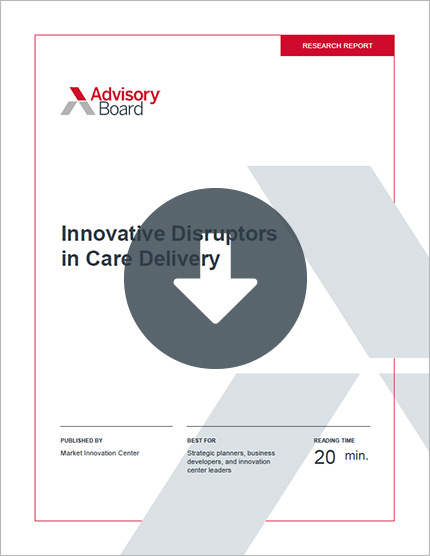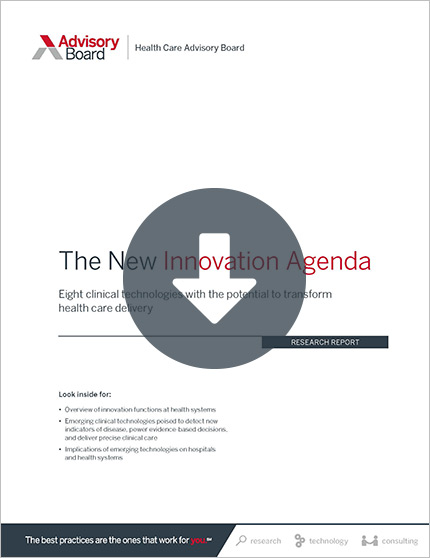Auto logout in seconds.
Continue LogoutRead Advisory Board's take: How can your hospital spur innovation?
In a recent survey of more than 300 hospital and health system leaders by Reaction Data, the Mayo Clinic was named the best "model for innovation," while Kaiser Permanente was named the best at "delivering high quality care at a sustainable cost."
Survey details
For the survey, Reaction Data, a health care-specific research platform, polled 341 hospital and health system C-suite executives and department heads to identify leading organizations for innovation, thought leadership, and quality of care. The respondents were not given prompts and could choose whatever organization they wanted.
Survey findings
Overall, the survey found the top five health systems in 2018 across the three surveyed dimensions of innovation, thought leadership, and quality of care were:
- Mayo Clinic (Rochester, Minnesota);
- Cleveland Clinic (Cleveland);
- Kaiser Permanente (Oakland, California);
- Intermountain Healthcare (Salt Lake City); and
- Geisinger Health System (Danville, Pennsylvania).
The rankings shifted slightly when researchers looked at each of the three factors individually. For example, when respondents were asked, "What health care system comes to mind as a model for innovation?", the eight most-cited hospitals were:
- Mayo Clinic;
- Cleveland Clinic;
- Intermountain Healthcare;
- Kaiser Permanente;
- Geisinger Health;
- Johns Hopkins (Baltimore);
- Advocate Health (Chicago); and
- Virginia Mason (Seattle).
When respondents were asked, "What health care system comes to mind as a model for delivering high quality care at a sustainable cost?", the eight most-cited hospitals were:
- Kaiser Permanente;
- Cleveland Clinic;
- Mayo Clinic;
- Intermountain Healthcare;
- Geisinger Health;
- Johns Hopkins;
- Advocate Health; and
- HCA Healthcare (Nashville, Tennessee).
When asked about a health care system that "comes to mind as a thought leader on topics related to health care transformation," respondents named:
- Mayo Clinic;
- Cleveland Clinic;
- Kaiser Permanente;
- Intermountain Healthcare;
- Geisinger Health;
- Ascension Health (Edmundson, Missouri); and
- Virginia Mason (Cohen, Becker's Hospital Review, 2/5; Reaction Data report, accessed 2/6).
Advisory Board's take

Alicia Daugherty, Managing Director, Market Innovation Center and Nadeem Farooqi, Senior Analyst, Service Line Strategy Advisor
Today's transformative market forces—slowing growth rates, new market entrants, rising physician alignment, and increasing M&A activity—necessitate innovation, not incremental change.
So how can your organization become more innovative? One path we've seen many providers take is to create innovation centers. Here's how hospitals and health systems around the country have been able to achieve their strategic goals using the innovation center model:
- Hartford Hospital reduced care variation: Innovation centers offer a forum for cross-industry experts to collaborate on improvements to care delivery. At Hartford Hospital's Center for Education, Simulation, and Innovation, experts uncovered the opportunity to revamp protocols to improve outcomes for patients experiencing cardiac arrest within the hospital. Their revised approach, which involved a Rapid Response Team to detect early warning signs of cardiac arrest, resulted in a decline in the incidence of cardiac arrest.
-
“Their initiative paid off with net revenues of $800,000+ per month.”
- The University of California lowered costs: Innovation centers have the potential to introduce solutions that increase efficiency and reduce costs. In fact, The University of California projected a net financial gain of $40 million from investing in its own Center for Health Quality and Innovation, with returns stemming from initiatives started at the Center. For example, the Center's multidisciplinary innovation team identified bottlenecks in the patient discharge process that undermined efficiency. In addressing this issue, UCLA increased patient understanding of post-discharge medication orders, and their initiative paid off with net revenues of more than $800,000 per month.
- El Camino Hospital attracted new talent: In a world of growing physician alignment and increasing competition, innovation centers can differentiate a health system as forward-thinking– and attract the business and affiliation of similarly minded providers. For instance, at El Camino Hospital, administrators noted increased interest in affiliation from Mountain View area physicians after partnering with the Fogarty Institute for Innovation, a group that provides intellectual, physical, and financial resources to emerging medtech companies that address major unmet clinical needs.
- Medstar is building patient loyalty. The MedStar Institute for Innovation has hosted pitch competitions to incubate start-up solutions and redefine convenient, consumer-friendly health care. The winners included startups such as Level Therapy, which allows patients to have mobile therapy sessions with licensed clinicians remotely. Medstar works with winners to test, validate, and scale innovations that can appeal to patients. As organizations struggle to respond to rising patient consumerism, partnerships with start-ups and innovators may offer the spark to win and retain patients through convenient, personalized care. In addition, this digital embeddedness can promote engagement through remote health management, hardwire care coordination to prevent downstream leakage, and create frictionless interactions which encourage consumers to attend preventive visits.
There is no one-size-fits all model for these centers. However, our research has found that these are four necessary components of the innovation process that must be addressed across all models to ensure success.
To learn these four elements, and to read other case studies of successful innovation, read our report on Developing High-Impact Innovation Centers.
Here are 8 clinical technologies that could transform health care delivery
Our new report explores the clinical technology pipeline to help health care leaders become more conversant in the major vectors of innovation, leading applications of new technologies, and the business implications for established providers. Read on to unpack the new innovation agenda.
Don't miss out on the latest Advisory Board insights
Create your free account to access 1 resource, including the latest research and webinars.
Want access without creating an account?
You have 1 free members-only resource remaining this month.
1 free members-only resources remaining
1 free members-only resources remaining
You've reached your limit of free insights
Become a member to access all of Advisory Board's resources, events, and experts
Never miss out on the latest innovative health care content tailored to you.
Benefits include:
You've reached your limit of free insights
Become a member to access all of Advisory Board's resources, events, and experts
Never miss out on the latest innovative health care content tailored to you.
Benefits include:
This content is available through your Curated Research partnership with Advisory Board. Click on ‘view this resource’ to read the full piece
Email ask@advisory.com to learn more
Click on ‘Become a Member’ to learn about the benefits of a Full-Access partnership with Advisory Board
Never miss out on the latest innovative health care content tailored to you.
Benefits Include:
This is for members only. Learn more.
Click on ‘Become a Member’ to learn about the benefits of a Full-Access partnership with Advisory Board
Never miss out on the latest innovative health care content tailored to you.


